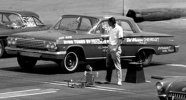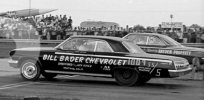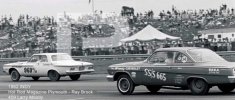You are using an out of date browser. It may not display this or other websites correctly.
You should upgrade or use an alternative browser.
You should upgrade or use an alternative browser.
Three photos of '62 Chevy's I found this morning, and posted on my website (georgeklass.net)
- Thread starter George Klass
- Start date
George Klass
Well Known Member
I did have a book published once, in the 1970's, but it was not about drag racing, it was a history of fire apparatus of the Los Angeles Fire Department. As far as your other question, most of the S/S racers were very friendly and easy to talk to. Guys like Landy, and Nicholson, Proffitt, Ronda, Butch Leal, etc. and all of the rest of the SoCal S/S racers were very personable. And why not, they raced against each other almost every weekend. As far as who was the most knowledgeable, I really can't say. I would really think that the racers that built and tuned their own engines and set up their own chassis, rather than just serving as drivers, probably knew more than those that only drove the cars.Love your pictures George! Have you ever published a book with pics and memories?
Im curious. Who was most personable racer or mechanic and who was least so? Who was most knowledgable of those 2 groups?
Some more info about the photos above. Butch Leal basically had a two-man team, Butch and his dad. They flat-towed (tow-bar) down to the local race tracks around SoCal from Pixley, a little town north of Bakersfield. Butch's dad owned a trucking company. It was about a 150 mile two in each direction. Spectators in the pit were always available when it came to helping out the S/S racers, loading and unloading the cars from trailers, or just getting them hot dogs from the food stands between rounds. Some of the racers would show up alone, with no crew help at all, so everyone would pitch in if they were needed.
The photo with Proffitt racing Jack Bayer. Those two were close friends. At one point before Hayden went to work at M/T's shop with the Pontiacs, Hayden drove a dual engine dragster owned by Bayer & Frietas. Jack was a good racer, and also tuned and drove one of the original Z-11 Chevy's.
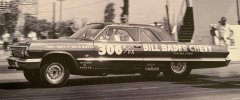
You have to forgive me, I’m 83 years old and my memory is not what it used to be. In fact, nothing is the way it used to be.
There was a time (1950’s and 1960’s) when we had 14 different drag strips in the greater Los Angeles area. Regardless of which track I went to on the weekends, I knew that I would see a Super Stock “heavyweight” racing another Super Stock “heavyweight”. There were so many nationally known S/S racers living in SoCal, it was almost unbelievable.
When I think about a “heavyweight” S/S racer, I’m remembering more than the driver’s name, I’m remembering the brand of his (or her) car and their sponsors name. A “heavyweight” racer did not just race locally, they towed their race cars all over the nation, either following drag racing National Events, or just booked-in match races.
Yesterday I was sitting in my Lazy-Boy chair watching college football and thinking about those drag racing glory days, and I decided to try and come up with a list of our local “heavyweights” back in the day. Far too many of them have passed away, and I’m sure I will only remember some of the racers names. I do remember the names of a lot of their sponsors, which were typically new car dealers. I will rely on you youngsters to fill in whatever I have forgotten.
I’ll do this by vehicle brand.
CHEVROLET
Don Nicholson – Service Chevrolet (I purchased my ’62 409/409 Bubble Top at Service Chevrolet)
Jack Bayer – Bill Bader Chevrolet
Hayden Proffitt – Cone Chevrolet
Tom Jacobson – Gledhill Chevrolet
Butch Leal – (Butch lived out of town but we saw him so many times we thought of him as a local) – Del Munson Chevorlet
Sometimes I remember only the driver’s name, and sometimes only who sponsored his car.
Tom Sturm
Terry Prince
Bud Eyre Chevrolet
J&M Speed Center
Brent’s Dyno Center
Ernie Porter Chevrolet.
And probably dozens more.
PONTIAC (This was the smallest group)
Hayden Proffitt – M/T
Shirley Shahan
Lloyd Cox & Carol Cox
Jess Tyree
DODGE & PLYMOUTH
Butch Leal
Glenn Thomas Dodge
Hayden Proffitt
Al Vanderwoude (the Flying Dutchman)
Bob Smith Dodge
Dick Landy
Blairs Speed Shop
Milne Brothers Plymouth
Ken Duttweiler
Bill Golden (Maverick)
Ritchie & Richie
Yeakel Plymouth
Art Carr
Al Roberts Plymouth
Bourgeois & Wade
Mashak Plymouth
Engine Masters
And many more. There were always more Mopar racers than any other brand.
FORD
Les Ritchie – Performance Associates
Dick Landy – Andy Andrews Used Cars
Ellico Ford
Gas Ronda - Downtown Ford
Desert Motors Ford
Galpin Ford
Mel Burns Ford
Downey Ford
Last edited:
George Klass
Well Known Member
Well, that's not going to happen. It's easier to just add photos to my website. When I first started that project (2013), I did not put any captions under the photos. Since then, I have added captions to some (but not all) the photos. I'm inherently lazy. But I did design the website to be like going to the drag races. When most people go to the drag races and wander through the pits, they "look" at the race cars (there are no captions attached to looking). So, instead of walking through the pits, you can just scroll down and look at the photos. There are no costs for parking your car, no charge for a pit pass, everything is FREE, and you won't get a sun burn on a hot day...You should write a book with many of your pictures as well as remembrances...some names changed to protect the not so innocent.
Put me down for 2 signed books!!
Last edited:
I have boxes of photos but they are from the late 80s into the mid 90s.
I also found that out of a 36 exposer roll of film,I may get one good picture.
I also found that out of a 36 exposer roll of film,I may get one good picture.
wristpin
Well Known Member
Your pictures are wonderful. I was hoping you'd put down memories too. Thank you for your website and for posting hereWell, that's not going to happen. It's easier to just add photos to my website. When I first started that project (2013), I did not put any captions under the photos. Since then, I have added captions to some (but not all) the photos. I'm inherently lazy. But I did design the website to be like going to the drag races. When most people go to the drag races and wander through the pits, they "look" at the race cars (there are no captions attached to looking). So, instead of walking through the pits, you can just scroll down and look at the photos. There are no costs for parking your car, no charge for a pit pass, everything is FREE, and you won't get a sun burn on a hot day...
George Klass
Well Known Member
I have tried to keep the cut-off date on the photos on my website to around 1965 or later. I have not always been successful at that.I have boxes of photos but they are from the late 80s into the mid 90s.
I also found that out of a 36 exposer roll of film,I may get one good picture.
George Klass
Well Known Member
For those that have asked me about "writing a book", here it is, cover to cover.
The age old question, “Where were you in Sixty Two?”
There is always a lot of talk about “nostalgia” and about “The glory years of Super Stock drag racing”. In my opinion (I was 23 years old in 1962), there were no “glory years” when it came to Super Stock drag racing, there was only one glory year. 1962.
1962 was a pivotal year in “Super Stock” drag racing. It was probably the ONLY year in which factory produced Super Stock drag cars could be purchased by anyone off the showroom floor, driven on the street and taken down to the local drag strip and raced. These were cars that were not designed or modified just for racing, although they were high performance cars. These were cars that you could purchase without “knowing somebody”. These were cars the factory produced in quantity, not just a dozen cars exclusively for competition. It never really happened prior to 1962 and it was over by 1963.
And the interesting thing is that all the major brands, Chevy, Ford, Pontiac, Dodge and Plymouth participated in this unique and one time phenomenon in 1962.
In 1961, the Chevy 409 engine was factory installed in only 142 cars. Or, you could have purchased a 1961 Chevy with a 283 or 348 engine, and purchase the 409 engine separately over the counter at a Chevy dealer, and installed it yourself. That’s exactly what Dyno Don Nicholson did. His original white 1961 “bubble top” was originally equipped with the 348 engine, and Don did an engine swap. That was legal in 1961 but by 1962, NHRA mandated that the engines had to have been factory installed.
Chevy produced 8,909 cars with 409 engines in 1962, cars that anyone could purchase from your local Chevy dealer.
In the Chevy camp in 1962, racers like Hayden Proffitt, Butch Leal, Ronnie Sox, Dyno Don Nicholson, Dave Strickler and hundreds of other guys were drag racing with the Chevy 409, the same basic car that anyone could purchase at your local Chevy dealer. Of course, the serious racers “blue printed” their engines and modified the cars for racing in NHRA Super Stock, right up to the allowable modifications for the class. But anyone else could do it too. It didn’t take a lot to change over to the Atlas Bucron rear tires and add some exhaust cut-outs, and some 4:11 or 4:56 gears. Anyone could make these modifications and race at the local drag strips on Sunday, with a reasonable chance of winning the S/S class.
By 1963, the drag race Chevy’s such as the Z-11 were not usually seen in Chevy showrooms. They were in short supply and almost unavailable. GM’s decision to pull out of racing also didn’t help much. For all practical purposes, Chevy was done with Super Stock after 1962.
Over at the Pontiac dealers, the mighty Super Duty 421 could get the crowds excited. Again, these cars were available to anyone with the cash, but in much smaller quantities than the Chevy 409’s. Only 180 Catalina sedans and 16 Grand Prix cars were factory produced with the 421SD engine. Well known Pontiac racers in 1962 included Arnie Beswick, Jess Tyree, Arlen Vanke, Harold Ramsey, Lloyd and Carol Cox and Don Gay. The other 170 plus showroom 421 SD Pontiacs were snatched up by people that just wanted a fast car or wanted to do some S/S drag racing with the big name racers.
In 1963, the famed “swiss cheese” stockers were given to only a select few, and as race cars only, and never saw the inside of a Pontiac dealer showroom. Like Chevy, Pontiac never offered a true Super Stock car after 1962.
The Plymouth and Dodge dealers were selling their new 1962 models with a short- ram wedge 413 cubic inch engine, the majority of which were equipped with an efficient 3-speed Torqueflite automatic transmission. These cars, weighing in at a light (for the time) 3400 pounds could rattle off mid 13-second elapsed times and even high 12’s with the optional 4.56 rear end ratio. The stock headers even had a place for open exhaust when the customers decided to go drag racing. The 413 Max Wedge was available to any and all that wanted one. 214 Dodges and 298 Plymouths were produced by the factory with the 413 Max Wedge engine. Once more, drive it to the track, race, and drive it home.
The new 1962 Dodge and Plymouth’s were an instant hit. They had been good performers in the past but were less than exciting style wise and didn’t attract a lot of showroom attention.
By 1963, aluminum front clips had all but eliminated these cars from the legitimate “street ” car category. So, again, 1962 was an important year for Mopar. Hundreds of regular enthusiasts raced their Dodges and Plymouths at the local drag stirps successfully, along side Bud Faubel, Roger Lindamood, Al Ecstrand, The Ramchargers, Dick Landy, Bill “Maverick” Golden, and Tommy Grove.
And then there were the Fords.
If any one company was responsible for the “street n’ strip performance” phenomenon off the showroom floor, it had to be Ford. Ford actually released the first of their “serious” Super Stockers in 1960, a 352-inch High, 360 HP Performance engine.
In 1961, the Starliner could be had with an updated 390 inch engine with triple carbs, but in 1962, the 406 engine was available to all who desired it, right off the showroom floor. The power was there but the cars were a little heavy for drag racing but were popular on the street.
Ford, like most of the rest of the manufacturers, changed to a more “race only” configuration for 1963 with a special light weight Galaxie. Here again, the lightweight Galaxies were no longer street cars available in the show rooms. Racers like Gas Rhonda, Les Ritchey, Len Richter, Bill Lawton (Tasca Ford) were well known Ford Super Stock racers in 1962 and raced along side the other 406 Ford enthusiasts.
1962 was really the first and last year that the multi carb, solid cam, big inch, “street n’ strip” cars were manufactured in Detroit and could be purchased directly from the local car dealers. Sure, you could still purchase cars with the big-inch engines after 1962, but they were watered-down for street use. They were not Super Stockers. 1962 was the TRUE glory year for the Super Stockers, before the words “emissions” and “crash testing” and “fuel mileage standards” got in the way of all the fun.
I have always felt that had NHRA and the Automotive Companies wanted to, they could have extended the real Super Stocker years for a long time. As in 1962, the cars themselves should have all been (and were) true production vehicles, not cars with light weight body components and limited availability. Larger displacement engines (such as the 409) were just another extra cost “option”, and available in any or all production Chevys. The Z-11 “option” in 1963 should have been an engine option only, and not the entire car. The 427 engine should have been an extra cost option available in any Chevy sedan, a sedan built with a steel body just like all the other production sedans. This goes for the Pontiacs, Fords and Mopars, too. The Ford Thunderbolt should have been available to anyone that wanted a performance Fairlane, with the extra cost 427 engine. The car itself should have been the standard all steel production Fairlane, with the optional 427 engine. In short, any “performance options” should have started and ended with the engine only, and not any body or chassis parts.
All the Super Stockers should have been based on standard production street legal vehicles with VIN numbers that satisfied all the rules and regulations for driving on the street, in my opinion, exactly like it was in 1962. All body panels and chassis components must be identical to the body panels and chassis components used on any other model of the same style vehicle. Light weight body panels or chassis components are not permitted in any of the Stock Classes.
Here are the basic regulations, right out of the 1962 NHRA Rulebook for the Stock Car Section: “Twenty Three (23) classes in this section for American factory production automobiles. Classification is based on shipping weight divided by advertised horsepower rating. All cars must be factory assembly line produced and generally show-room sales available.”
So, where were you in 1962? Yeah, I know, some of your parents weren’t even adults yet. But I remember it like it was yesterday. I wish I still had my old 409 bubble top to play around with. Heck, I wish I was 23 again too.
The age old question, “Where were you in Sixty Two?”
There is always a lot of talk about “nostalgia” and about “The glory years of Super Stock drag racing”. In my opinion (I was 23 years old in 1962), there were no “glory years” when it came to Super Stock drag racing, there was only one glory year. 1962.
1962 was a pivotal year in “Super Stock” drag racing. It was probably the ONLY year in which factory produced Super Stock drag cars could be purchased by anyone off the showroom floor, driven on the street and taken down to the local drag strip and raced. These were cars that were not designed or modified just for racing, although they were high performance cars. These were cars that you could purchase without “knowing somebody”. These were cars the factory produced in quantity, not just a dozen cars exclusively for competition. It never really happened prior to 1962 and it was over by 1963.
And the interesting thing is that all the major brands, Chevy, Ford, Pontiac, Dodge and Plymouth participated in this unique and one time phenomenon in 1962.
In 1961, the Chevy 409 engine was factory installed in only 142 cars. Or, you could have purchased a 1961 Chevy with a 283 or 348 engine, and purchase the 409 engine separately over the counter at a Chevy dealer, and installed it yourself. That’s exactly what Dyno Don Nicholson did. His original white 1961 “bubble top” was originally equipped with the 348 engine, and Don did an engine swap. That was legal in 1961 but by 1962, NHRA mandated that the engines had to have been factory installed.
Chevy produced 8,909 cars with 409 engines in 1962, cars that anyone could purchase from your local Chevy dealer.
In the Chevy camp in 1962, racers like Hayden Proffitt, Butch Leal, Ronnie Sox, Dyno Don Nicholson, Dave Strickler and hundreds of other guys were drag racing with the Chevy 409, the same basic car that anyone could purchase at your local Chevy dealer. Of course, the serious racers “blue printed” their engines and modified the cars for racing in NHRA Super Stock, right up to the allowable modifications for the class. But anyone else could do it too. It didn’t take a lot to change over to the Atlas Bucron rear tires and add some exhaust cut-outs, and some 4:11 or 4:56 gears. Anyone could make these modifications and race at the local drag strips on Sunday, with a reasonable chance of winning the S/S class.
By 1963, the drag race Chevy’s such as the Z-11 were not usually seen in Chevy showrooms. They were in short supply and almost unavailable. GM’s decision to pull out of racing also didn’t help much. For all practical purposes, Chevy was done with Super Stock after 1962.
Over at the Pontiac dealers, the mighty Super Duty 421 could get the crowds excited. Again, these cars were available to anyone with the cash, but in much smaller quantities than the Chevy 409’s. Only 180 Catalina sedans and 16 Grand Prix cars were factory produced with the 421SD engine. Well known Pontiac racers in 1962 included Arnie Beswick, Jess Tyree, Arlen Vanke, Harold Ramsey, Lloyd and Carol Cox and Don Gay. The other 170 plus showroom 421 SD Pontiacs were snatched up by people that just wanted a fast car or wanted to do some S/S drag racing with the big name racers.
In 1963, the famed “swiss cheese” stockers were given to only a select few, and as race cars only, and never saw the inside of a Pontiac dealer showroom. Like Chevy, Pontiac never offered a true Super Stock car after 1962.
The Plymouth and Dodge dealers were selling their new 1962 models with a short- ram wedge 413 cubic inch engine, the majority of which were equipped with an efficient 3-speed Torqueflite automatic transmission. These cars, weighing in at a light (for the time) 3400 pounds could rattle off mid 13-second elapsed times and even high 12’s with the optional 4.56 rear end ratio. The stock headers even had a place for open exhaust when the customers decided to go drag racing. The 413 Max Wedge was available to any and all that wanted one. 214 Dodges and 298 Plymouths were produced by the factory with the 413 Max Wedge engine. Once more, drive it to the track, race, and drive it home.
The new 1962 Dodge and Plymouth’s were an instant hit. They had been good performers in the past but were less than exciting style wise and didn’t attract a lot of showroom attention.
By 1963, aluminum front clips had all but eliminated these cars from the legitimate “street ” car category. So, again, 1962 was an important year for Mopar. Hundreds of regular enthusiasts raced their Dodges and Plymouths at the local drag stirps successfully, along side Bud Faubel, Roger Lindamood, Al Ecstrand, The Ramchargers, Dick Landy, Bill “Maverick” Golden, and Tommy Grove.
And then there were the Fords.
If any one company was responsible for the “street n’ strip performance” phenomenon off the showroom floor, it had to be Ford. Ford actually released the first of their “serious” Super Stockers in 1960, a 352-inch High, 360 HP Performance engine.
In 1961, the Starliner could be had with an updated 390 inch engine with triple carbs, but in 1962, the 406 engine was available to all who desired it, right off the showroom floor. The power was there but the cars were a little heavy for drag racing but were popular on the street.
Ford, like most of the rest of the manufacturers, changed to a more “race only” configuration for 1963 with a special light weight Galaxie. Here again, the lightweight Galaxies were no longer street cars available in the show rooms. Racers like Gas Rhonda, Les Ritchey, Len Richter, Bill Lawton (Tasca Ford) were well known Ford Super Stock racers in 1962 and raced along side the other 406 Ford enthusiasts.
1962 was really the first and last year that the multi carb, solid cam, big inch, “street n’ strip” cars were manufactured in Detroit and could be purchased directly from the local car dealers. Sure, you could still purchase cars with the big-inch engines after 1962, but they were watered-down for street use. They were not Super Stockers. 1962 was the TRUE glory year for the Super Stockers, before the words “emissions” and “crash testing” and “fuel mileage standards” got in the way of all the fun.
I have always felt that had NHRA and the Automotive Companies wanted to, they could have extended the real Super Stocker years for a long time. As in 1962, the cars themselves should have all been (and were) true production vehicles, not cars with light weight body components and limited availability. Larger displacement engines (such as the 409) were just another extra cost “option”, and available in any or all production Chevys. The Z-11 “option” in 1963 should have been an engine option only, and not the entire car. The 427 engine should have been an extra cost option available in any Chevy sedan, a sedan built with a steel body just like all the other production sedans. This goes for the Pontiacs, Fords and Mopars, too. The Ford Thunderbolt should have been available to anyone that wanted a performance Fairlane, with the extra cost 427 engine. The car itself should have been the standard all steel production Fairlane, with the optional 427 engine. In short, any “performance options” should have started and ended with the engine only, and not any body or chassis parts.
All the Super Stockers should have been based on standard production street legal vehicles with VIN numbers that satisfied all the rules and regulations for driving on the street, in my opinion, exactly like it was in 1962. All body panels and chassis components must be identical to the body panels and chassis components used on any other model of the same style vehicle. Light weight body panels or chassis components are not permitted in any of the Stock Classes.
Here are the basic regulations, right out of the 1962 NHRA Rulebook for the Stock Car Section: “Twenty Three (23) classes in this section for American factory production automobiles. Classification is based on shipping weight divided by advertised horsepower rating. All cars must be factory assembly line produced and generally show-room sales available.”
So, where were you in 1962? Yeah, I know, some of your parents weren’t even adults yet. But I remember it like it was yesterday. I wish I still had my old 409 bubble top to play around with. Heck, I wish I was 23 again too.
Last edited:
I was 4 years old then, didn't get a brownie camera yet.
jbschneeweis
Well Known Member
Great book. Wish I could remember all that!
I was 21 years old & lived on the east coast. Went to York US 30 Dragway in Lancaster, PA. & saw Dave Strickler & Bill Jenkins 61 409 race. Said I have to have one of those. Went to Dick Barone Chevrolet Dealership in Springfield, PA & ordered one. Delivered in early 62 was my car. 1962 Biscayne 409, 4 speed, dual quad & 456 rear. Raced on the east coast for about 2 years & then joined the Army. Even raced against Dave Strickler, Northwind & Arnie Beswick. Needless to say I lost those races. Did take the SS class a few times when the big guns weren't there. Even had Bill Jenkins tune my car, he worked out of a Sunoco Gas Station in Berwyn, PA. On the one video of the SS races & drag strips from 1962 that is me in the black 62 at the Vineland, NJ strip. Wish I had taken more pictures, have very few. Don't know what happened to the car. I took it back to the dealer & traded it in on a 1964 Corvair for my parents. Then off the the military. Big leap forward & decided it was time to race again & here I am having fun racing a 409 again with the beat group of people with the same interest. Thanks everyone. See you again in 2023.
Joel
I was 21 years old & lived on the east coast. Went to York US 30 Dragway in Lancaster, PA. & saw Dave Strickler & Bill Jenkins 61 409 race. Said I have to have one of those. Went to Dick Barone Chevrolet Dealership in Springfield, PA & ordered one. Delivered in early 62 was my car. 1962 Biscayne 409, 4 speed, dual quad & 456 rear. Raced on the east coast for about 2 years & then joined the Army. Even raced against Dave Strickler, Northwind & Arnie Beswick. Needless to say I lost those races. Did take the SS class a few times when the big guns weren't there. Even had Bill Jenkins tune my car, he worked out of a Sunoco Gas Station in Berwyn, PA. On the one video of the SS races & drag strips from 1962 that is me in the black 62 at the Vineland, NJ strip. Wish I had taken more pictures, have very few. Don't know what happened to the car. I took it back to the dealer & traded it in on a 1964 Corvair for my parents. Then off the the military. Big leap forward & decided it was time to race again & here I am having fun racing a 409 again with the beat group of people with the same interest. Thanks everyone. See you again in 2023.
Joel

George Klass
Well Known Member
Let's see if we can dissect the S/S class in 1962. Here are the players, Chevy, Ford, Pontiac, Dodge and Plymouth. First and foremost is that the automotive factories wanted to sell their respective brands. With the possible exception of the Pontiacs, the rest of the competitors fell into the same basic class of automobiles, price wise. NHRA put a cap on displacement, so none of the high performance engines could be larger than 427 cubic inches in the S/S class. The largest displacement engine was Pontiac's 421, but then Pontiac's also were saddled with the highest curb weight. Chevy had 409 cubes, Ford had 406 cubes, the Dodges and Plymouths had 413 cubes. Based on horsepower, the Pontiac was probably the most powerful (all the engines were of the Wedge design). The Stock Classes were classified using a formula of "vehicle weight divided by advertised horsepower". Does anyone reading this believe that the advertised horsepower of each of the players was completely accurate? In the SS/S and SS/SA classes, it was 0.00 to 9.89 lbs per advertised horsepower. The 409 Chevy probably weighed in around 3400 lbs for the 2-door Biscayne, and the Bel Air hard top and Impala just a little more. The 409 engine had an advertised horsepower rating of 409 HP. 3400 Lbs. divided by 409 HP equals 8.31, which obviously fits between 0.00 and 9.89. All of the players had to (and did) fit into that category. Some of the Pontiac models were right on the borderline between SS/S, S/S and A/S. The other things to consider were the transmissions. In my opinion, transmissions were one of the most important pieces of the puzzle if you were using the car as a drag car. Most of the players using manual transmissions had a 4-speed trans, all except Pontiac, which still had only a 3-speed trans until late in the 1962 season. All had the ability to use an automatic transmission, too. The best auto trans in 1962 (in my opinion) was the TorqueFlite on the Dodge and Plymouth players. It's important to remember that the legal drag tires in the class were limited to a 7-inch tread width. The vast majority of S/S players used the manual transmissions, other than the majority of the Mopar teams, which used the auto trans. Between curb weight, horsepower, tire size and transmission, I have always felt that the TorqueFlite trans had the best "balance" between all the other issues. The 1962 Fords were just a little too heavy for the HP of the Blue Oval engine, and the Ford auto trans was okay, but not great. The Pontiac had two things going against them in the S/S classes. "A", they were the heaviest of the players, and "B", they were more expensive to purchase with the 421 engine. Pontiac did have a very good automatic trans, but it was heavier than than the auto trans on the Mopars. When you put all these factors into the blender, the 4-speed Chevy had a lot of advantages. Hayden once told me that the Chevy's "weight transfer" ability was the best of all the players. He was a firm believer that raising the front end 2 1/2-inches and lowering the rear by the same amount was ideal. Nicholson also went with that theory. The Dodge and Plymouth racers usually raised both the front end and the rear by the allowable 2 1/2-inches, which worked well with those guys. Each of the players and their chosen brand had positives and negatives they had to balance out. I looked at all the brands before buying my 409/409 4-speed Chevy bubble top, and did a comparison, and found that the most important feature (for me) was that it was the most affordable to buy and maintain (I broke the tranny twice and the rear end once, all were taken care of under the new car warranty). I bought some headers that Don Nicholson had used on his 1961 409, and he pulled the cylinder heads off and removed one of the two head gaskets on each bank to give me more compression, and fiddled with the carbs. Although I drag raced the car on the weekends, it was primarily my street car (yes, I street raced a lot). I can admit that now, the Statute of Limitations is finally over...
Last edited:
George Klass
Well Known Member
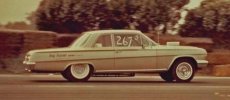
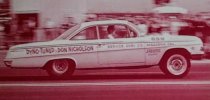
Unlike 1961 when Pontiac, Chevy and even Ford offered a "bubble" top 2-door sedan, only Chevy had them in 1962. The 1962 Pontiacs, Fords, Dodges and Plymouths all had the basic notch-back roof line on their 2-door sedans. I did some "research" a month or two ago on the so-called issue regarding which roof style had the aerodynamic advantage on the Chevy S/S cars. The average Top Speed at NHRA National Events for Chevy Super Stock cars listed for the heavy hitters, at the same tracks on the same day was between 109 and 111 MPH, regardless of which roof style they had. I think that many people (including me) thought that the "bubble" top style had the advantage, but such was not the case. When you think about it, these cars were not running 150+ MPH. They all were averaging about 110 MPH through the traps. At 110 MPH, the aerodynamic difference on the Chevy's between the two roof styles was apparently not enough to make a measurable difference...
Was the bubble top a lighter car?
George Klass
Well Known Member
When it comes to weight, there is curb weight and shipping weight. I do not know which were used below. NHRA uses shipping weight:Was the bubble top a lighter car?
The Biscayne 2-door sedan weighs in at 3380 Lbs.
The Bel Air 2-door sedan weighs in at 3385 Lbs.
The Bel Air Sport Coupe (the bubble top) weighs in at 3420 Lbs.
The Impala Sport Coupe weighs in at 3430 Lbs.
All of the above weights are with the 283-inch Small Block engine. I seem to remember that the 409 engine was about 80 Lbs more, but I could be wrong. The important thing here is not so much the weights listed for each model, but the DIFFERENCE between the weights for each model. For instance, the 2-door Biscayne weighed 40 Lbs. less than the "bubble" top. Also, I was surprised that the Impala Sport Coupe was only 10 Lbs more than the Bel Air "bubble" top.
Interesting, eh what?
I keep thinking the 62 Bel Air I have been racing with a iron head 409, Th 350 transmission, 9.3 P/O rear end and a single racing bucket seat with me in it weighed in at 3680
George Klass
Well Known Member
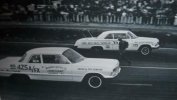
In 1963, after the introduction of the Z-11 Impalas for the FX class, and because availability was so limited, I knew several Chevy racers that purchased the Biscayne 2-door sedan, and the aluminum sheet metal front clip, and the Z-11 engine, and created great running A/FX cars. It netted a 50 Lbs weight advantage over the Impala version. For racers that had to pay for their Z-11's, buying the Biscayne and buying the light weight body parts over the counter, and the engine, from your friendly Chevy dealer saved a lot of moola. Let me tell you, 50 Lbs is a lot of weight saving in drag racing. As for price, the 1963 Z-11 impala listed for $4,000. Buying the Biscayne 2-door sedan in '63 (with the 283 engine) would cost you $2,429 (and you could sell the 283 engine and offset the cost a little). In fact, I have heard of several Chevy dealers that would purchase the 283 engine from you...
Last edited:
62_Conv_2-4s
Well Known Member
Hey George why not have someone write the book for you. You can supply all the information and the pictures and have last say after it is completed. I think there would be a big market for it. Your insight in to what happen in NHRA back in the 60's is very valuable and worth saving for future reference and the history of the sport.

